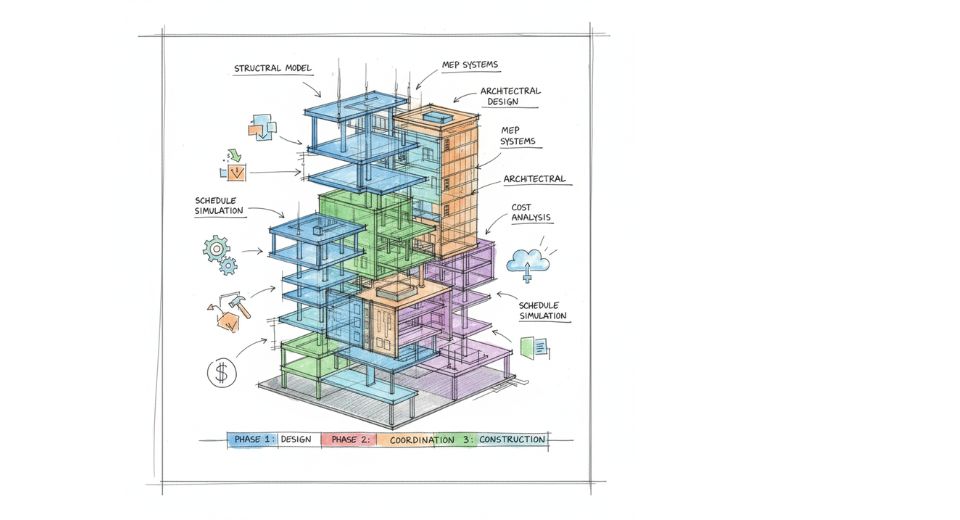
Sep 29, 2025

The newest analysis of the Global Building Information Modeling (BIM) Market by Metastat Insight is linked straight to the construction of cities, offices, and houses to meet contemporary demands. The idea resonates with day-to-day life more than it seems either in the longevity of an apartment building, effectiveness of a public transit center, or sustainability of a new hospital. With societies calling for safer buildings, less waste, and more efficiency, digital modeling has transitioned from an add-on tool to a necessary foundation for the construction and infrastructure industries. The increased focus around the technology is not only a market preference but also a shift in how the built world gets designed, managed, and maintained. context in today's construction environment
Construction today is on the verge of a period of high sophistication demands.
Projects are growing larger and more technically complex, with shorter timelines and reduced resources. The industry needs to react to international calls for sustainability while maintaining long-term safety and resistance. In this environment, antiquated approaches cause risk and inefficiencies that cannot be overlooked. Digital modeling comes in as a reaction to these escalating challenges, offering a structured and astute method to planning, coordination, and delivery. Its capability of unifying architecture, engineering, and construction in a single context has turned it into something greater than a planning tool; it has turned it into a strategic facilitator for the delivery of consistent outcomes in the face of increased pressure. how digital modeling delivers value. As its core function, digital modeling offers a living model of physical assets.
It brings design, materials, schedules, and operation data together in a single environment that can be revised and shared in real time.
It dispenses with silos, minimizes misunderstandings, and enables stakeholders to make informed decisions prior to breaking ground. The advantages go far beyond delivering a project. Once a building is finished, the same model facilitates long-term operation and maintenance, lowering life-cycle costs and enhancing energy performance. Why this method is worthwhile is not only because it is accurate but also because it is flexible enough to allow complicated projects to develop without compromising on quality or efficiency. evolution of adoption Adoption of this method did not occur overnight. In the beginning, uptake was silent, with just certain projects testing digital coordination.
Gradually, as benefits became apparent, the technology progressed from testing phases to wider acceptance.
Advances in cloud connectivity, mobile access, and data visualization have driven its adoption, making it simpler to collaborate even between continents. Sustained innovation has cemented its footprint, including artificial intelligence integration for predictive analytics and support for evolving sustainability norms. Growth in the market mirrors a narrative of incremental trust establishment, where steady performance has persuaded an industry historically hankering for change. regional and worldwide adoption trends Levels of implementation vary widely across geographies. Certain geographies have already adopted digital modeling early on, led by the regulatory environment, aggressive infrastructure plans, and the need for urbanization. Such geographies now have high levels of advanced maturity in both public and private sectors.
In the meantime, rapidly expanding economies are realizing the benefits of embracing these practices as construction activity picks up and infrastructure spending gathers pace.
The blend of new industries, urban growth, and official interest in digitalization provides rich soil for growth. In this context, adoption is varied, yet every area uniquely adds to global advancement of the technology. obstacles and potential ahead. Although it's evident advantages, issues exist. Adoption can involve initial expense in technology and education, creating hurdles for small businesses. Regulations and standards also differ, making cross-border projects difficult. Competition among software ecosystems has the potential to create integration challenges.
However, these are backed by substantial opportunities.
Progress in automation, greater availability of cloud platforms, and tighter coupling with smart city programs provide avenues for wider application. Extension into facility management, city planning, and infrastructure resilience provides new opportunities for the technology to demonstrate its value. Instead of stalling development, challenges are creating a space in which innovation keeps unfolding. why it matters in the current context. Its significance is linked to broader global priorities. Sustainability objectives require more intelligent usage of materials and energy-efficient constructions. Urban dwellers need secure accommodation, transport, and public amenities provided within limited budgets. Digital change is transforming all industries, and construction cannot stay behind.
Here, the view of the Global Building Information Modeling (BIM) Market by Metastat Insight illustrates why the technology is set to become integral to the way the future built world will materialize. By bridging digital smarts and physical construction, it is creating a base for more secure, more sustainable, and more efficient cities. As industries adapt to these expectations, the trend of digital modeling guarantees that it will carry on shaping how human spaces are created and maintained.
Drop us an email at:
Call us on:
+1 5186502376
+91 73850 57479